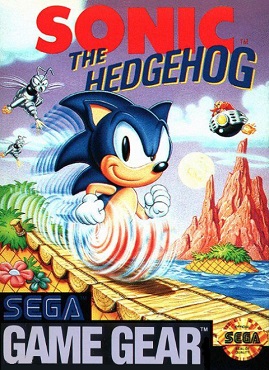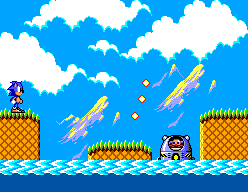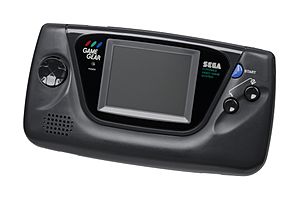Sonic the Hedgehog (8-bit video game) facts for kids
Quick facts for kids Sonic the Hedgehog |
|
|---|---|

North American Game Gear cover art
|
|
| Developer(s) | Ancient |
| Publisher(s) | Sega |
| Director(s) | Ayano Koshiro |
| Programmer(s) | Shinobu Hayashi |
| Artist(s) |
|
| Composer(s) | Yuzo Koshiro |
| Series | Sonic the Hedgehog |
| Platform(s) | |
| Release date(s) | Master System
Game Gear December 28, 1991 |
| Genre(s) | Platform |
| Mode(s) | Single-player |
Sonic the Hedgehog is a fun side-scrolling platform game from 1991. It was made for the 8-bit Game Gear and Master System consoles. This game is like a companion to the bigger 16-bit Sonic the Hedgehog game that came out on the Sega Genesis.
The company Ancient developed this 8-bit Sonic game. It was founded by the composer Yuzo Koshiro just for this project. Sega published the game to help promote their new handheld system, the Game Gear. The 8-bit Sonic plays a lot like the 16-bit version, but it was made simpler to work on the less powerful 8-bit systems.
The story of the 8-bit Sonic is the same as the 16-bit game. You play as Sonic, a super-fast hedgehog. Your goal is to race through levels and save the animals that the evil Doctor Robotnik has trapped. He wants to turn them into robots! Just like in the original, Sonic collects rings and tries to avoid dangers. However, this 8-bit version is a bit slower and focuses more on exploring the levels. Some levels, like Green Hill Zone, are inspired by the 16-bit game, but many are brand new. The music is also different, with new songs by Yuzo Koshiro and some remixes of the 16-bit game's tunes.
When it first came out, people really liked the 8-bit Sonic. They praised its different levels, cool graphics, fun gameplay, and awesome music. Many thought it was just as good as the 16-bit version. Some players felt it was a bit too easy or too short. Today, game experts still think it's one of the best games for the Game Gear and Master System. You can find this 8-bit Sonic game on different Sonic game collections and Nintendo's Virtual Console. It also led to other games, starting with Sonic the Hedgehog 2 in 1992. This was Ancient's first game, and the only Sonic game they ever made.
Contents
Playing the Game: How Sonic Saves the Day

The 8-bit Sonic the Hedgehog is a side-scrolling platform game. It plays a lot like the original 16-bit game of the same name, but with some cool new features. In the game, Sonic is an animal character who needs to save the animals of South Island. The bad guy, Doctor Robotnik, wants to turn them into robots.
As Sonic, you jump on platforms, dodge enemies, and avoid obstacles. You can also smash televisions to get helpful items like shields, speed shoes, or even invincibility. These TVs also mark checkpoints so you don't have to start all over if you lose a life. Just like in the original game, Sonic collects rings. If you have rings, they protect you from getting hurt by an enemy or obstacle.
You start the game with three lives. If you get hit without any rings, fall into a pit, or drown, you lose a life. If you lose all your lives, it's "game over" and you have to start the game again. The gameplay in this 8-bit version is a little slower than the 16-bit game. It focuses more on exploring the levels and finding hidden paths.
Exploring the Zones: Levels and Boss Fights
Sonic travels through six different levels, which are called zones. Each zone has two main parts, called acts, and then a boss battle against Doctor Robotnik. The zones have different themes, like grassy fields, old ruins, and thick jungles.
Some of the zone themes, like Green Hill Zone, are from the 16-bit game. But many others are completely new! All the level designs are different, and you won't find any vertical loops like in the bigger game. Some levels need you to be very precise with your jumps. In other levels, you'll even have to go underwater!
Hidden in some acts are special items called Chaos Emeralds. You need to find all six of them to get the best ending for the game. At the end of each main act, you hit a signpost. This signpost spins and lands on an image, which can give you bonus points or items. If you have more than 50 rings, you can enter a pinball-like bonus stage. Here, you can collect even more rings and extra continues to help you keep playing.
Making the Game: How Sonic Came to Life
In 1990, Sega released the Game Gear. This was an 8-bit handheld game console that Sega hoped would compete with Nintendo's Game Boy. Around the same time, the Sonic team was busy making the 16-bit Sonic the Hedgehog for the Genesis. Sega wanted to make sure everyone knew about the Game Gear. So, they decided to create a special Sonic game just for it.
Yuzo Koshiro, who was 22 years old at the time, had just started working with Sega. He had composed music for another game called The Revenge of Shinobi. After that, he told a Sega manager that he could develop games himself. Because of this, a general manager asked him to start making a Game Gear version of Sonic.
Koshiro then started his own company called Ancient to develop the game. Sega couldn't make contracts with individual people, so a company was needed. His sister, Ayano Koshiro, became the director of the game. His mother, Tomo Koshiro, helped behind the scenes. The first programmer he hired was Shinobu Hayashi. The 8-bit Sonic was made specifically for the Game Gear. But Sega also asked Ancient to make a version for the Master System, which was selling well and had similar parts.
Building a New Sonic: Challenges and Creativity
It was impossible to simply copy the original 16-bit game onto the 8-bit systems. So, Ancient had to build their Sonic game from scratch. The team decided to make their version totally different from the 16-bit one. According to Koshiro, the game was made in three stages. In the first stage, Ancient thought about the 16-bit game. But the second and third stages were mostly Ancient's own ideas, with Sega checking their work.
Koshiro found it challenging to create a new Sonic for 8-bit systems. He didn't work directly for Sega, and he had never developed a game before. However, Sega trusted him because of his good relationship with the company. Koshiro also composed the music for the game. He wanted to keep the same feeling as the 16-bit version's music. He tried to convert the 16-bit Sonic music by Masato Nakamura to the 8-bit sound system. But in the end, he only used three of those songs. All the other music in the game is Koshiro's original work.
Game History: When and Where Sonic Appeared

Even though the Game Gear version was made first, Sega released the 8-bit Sonic for the Master System in Europe in November 1991. Then, it came out worldwide for the Game Gear on December 28, 1991. In Europe, later versions of the Master System even had the game built right into them! In North America, it was one of the last games released for the Master System.
The Master System didn't sell very well in North America. Because of this, its version of Sonic became a special item for collectors. The American Master System release was actually just an import of the European version. Sega simply covered the European barcode on the game box with an American one. Nintendo World Report called the game a "weird" release for the Sonic series because it wasn't all about speed. Even though the 8-bit Sonic made money for Sega, it didn't sell as well as the 16-bit original.
Re-releases: Playing Sonic on New Systems
This game has been released again on different systems using emulators. In 2003, Sega released Sonic Adventure DX: Director's Cut. This was an improved version of the 1998 Sonic Adventure game for the GameCube and Windows computers. As you played through Sonic Adventure DX, you could unlock all 12 Sonic games that came out for the Game Gear, including this 8-bit Sonic.
The Game Gear version is also part of Sonic Mega Collection Plus (2004). This is a collection of Sonic games for Windows, PlayStation 2, and Xbox. Sega also released the Master System version for the Wii's Virtual Console service. This happened in Japan and North America in August 2008, and in Europe the next month. The Game Gear version was released for the Nintendo 3DS's Virtual Console in the West on June 13, 2013, and in Japan on December 4, 2013.
Sonic's Impact: What Came Next
GamesRadar+ ranked the 8-bit Sonic as the fourth best Game Gear game. Both they and Retro Gamer said it was one of the best Master System games ever. This 8-bit Sonic was the very first game made by Ancient, and it was the only Sonic game they ever developed.
After this game, starting with its 1992 sequel, Sonic the Hedgehog 2, all other 8-bit Sonic platform games were made by a different company called Aspect Co.. The music from the Bridge Zone level in this game became very famous. It was even used as a basis for Tails' theme song in the game Sonic Adventure.
Some fans have even made their own versions of the game to play on other systems. In 2019, a fan-made remake of the game came out for Microsoft Windows and Android phones. This remake had a wider screen, new playable characters, new levels, and new ways to play. In December 2021, a fan-made version for the Commodore 64 computer was released. This version was created by carefully changing the original game's code to work on the Commodore 64's different processor.
Images for kids
See also
 In Spanish: Sonic the Hedgehog (videojuego de 8 bits) para niños
In Spanish: Sonic the Hedgehog (videojuego de 8 bits) para niños






